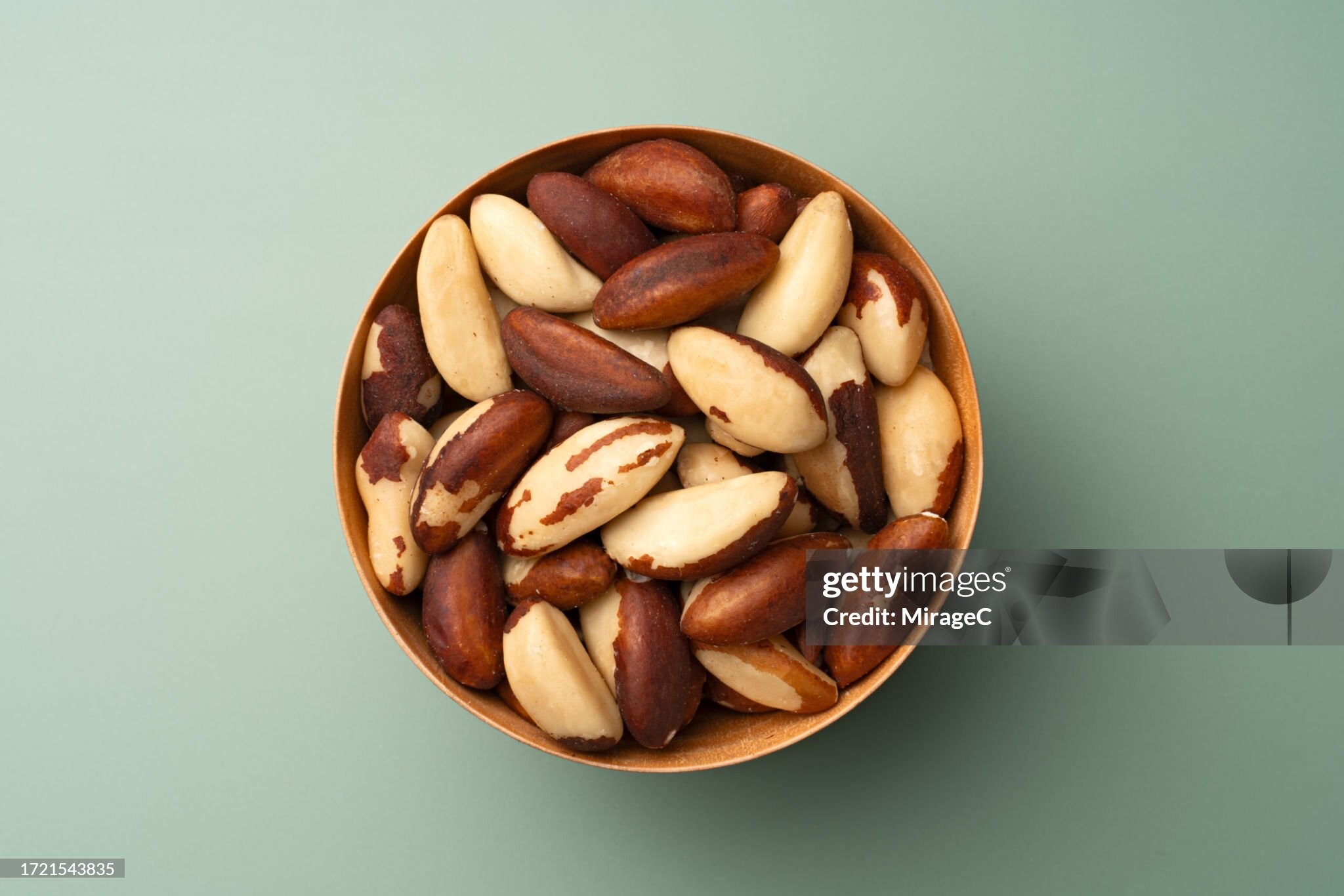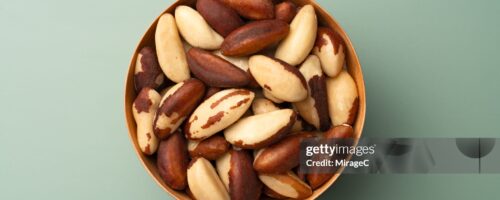
Northern Amazon region of Bolivia
How is it produced?
The production of Brazil nuts is unique because they can only be found in natural forests in the Amazonian ecosystem (Guariguata et al., 2017, p. 2007). These nuts come from the Bertholletia excelsa trees which often reach fifty meters in height, and their preservation is highly important to the efforts of conserving the Amazon (Guariguata et al., 2017, p. 2007). The nuts are found hidden in woody fruit capsules resembling coconuts, and they take around fifteen months to mature before naturally falling to the forest floor, typically around the wet season (Arriarán, n.d.). Harvesters, known as zafreros, trek through the forest to gather these fallen fruit capsules and split the hard outer shell to extract the nuts (Arriarán, n.d.). The collected nuts are carried to local collection centers called payoles (Naturland, 2000, p. 4). From there, they are transported by boat or truck to centralized processing factories known as beneficiadoras, often located in urban centers like Riberalta, Bolivia (van der Wal, 2021). Factory processing is labour-intensive, and involves, sorting, drying, boiling or steaming, cleaning, selecting and packing the nuts (Stoian, 2004, pp. 91-92). The shelling phase, where nuts are removed one by one is the most difficult, and is often performed by women known as quebradoras (Stoian, 2004, pp. 91-92).
Describe the supply chain to the store shelf in Canada:
The supply chain of Brazil nuts to the store shelf, including destinations like Canada, is characterized by bulk export from South America. Bolivia is currently the largest global producer and exporter, accounting for approximately 78% of the world’s Brazil nut production (van der Wal, 2021). The chain begins with harvesters, including individual zafreros, and others in the community such as Indigenous peoples, who deliver the raw, in-shell nuts to processing factories (Fair Labor Association, 2024, pp. 18). Then the middlemen frequently buy nuts from various sellers and deliver them to factory warehouses (Fair Labor Association, 2024, p. 19). The processing factories then package and export the shelled nuts in bulk (Fair Labor Association, 2024, p. 21). International importers, such as Voicevale, purchase these bulk nuts directly from the Bolivian factories (Fair Labor Association, 2024, p. 21). These importers then distribute the bulk commodity to major consuming markets, including Canada, which, in 2022, was a top destination for Bolivian Brazil nut exports, receiving 785 tons valued at $6.7 million (Fair Labor Association, 2024, p. 12). The international buyers distribute the nuts to food companies for use as ingredients in snacks and confectionery, or sell them to packagers including large grocery store retailers for retail sale, completing the journey to the shelf (Fair Labor Association, 2024, p. 21).
What is the power balance between the producer and seller?
The power balance in the Brazil nut supply chain is heavily unbalanced, favouring powerful actors such as international traders and retailers, over the harvesters and processing workers (van der Wal, 2021). International traders, packagers, and retailers collectively capture roughly half of the total gross margin of the commodity (van der Wal, 2021). In contrast, Bolivian harvest and processing workers receive only about 14% of the final retail price (van der Wal, 2021). Harvesters often operate under conditions of informal employment and lack written contracts, legal minimum wages, and social security coverage (van der Wal, 2021). Their precarious position is solidified by the widespread use of the habilito system, where harvesters receive advance loans, often leading them into a cycle of debt where they feel they are forced to labour merely to pay off previous obligations (Stoian, 2004, pp. 93-94). Despite market improvements benefiting processors and exporters, the wages paid to harvest workers have remained stagnant over the past decade (van der Wal, 2021). Furthermore, local actors have virtually no influence over price setting, which is dictated exclusively by the volatile international market, with price drops frequently passed directly down to the vulnerable harvesters (Stoian, 2004, p. 97).
Can you recommend changes to the system to improve the balance?
To improve the power balance and address exploitative conditions, I believe systemic changes focused on transparency and better circumstances are needed for the workers. Companies, including retailers, must acknowledge and take responsibility for improving wages and conditions throughout the supply chain. Addressing the dependency created by the habilito system is crucial, and this would require implementing financial alternatives. Establishing price transparency early in the harvest season through negotiations involving unions, companies, and government representatives could be one way to ensure this.
References/Resources:
Arriarán, E. M. (n.d.). Brazil Nuts: From Amazon Rainforests to Global Markets – A Sustainable Journey. Wikifarmer. Retrieved October 30, 2025, from https://wikifarmer.com/library/en/article/brazil-nuts-from-amazon-rainforests-to-global-markets-a-sustainable-journey
Fair Labor Association. (2024). Mapping Working Conditions and Labor Risks in Voicevale’s Brazil Nut Supply Chain in Bolivia (pp. 1–58). Fair Labor Association. https://www.fairlabor.org/wp-content/uploads/2024/05/05.23.2024-Baseline-Assessement-Voicevale-Brazil-Nuts-Bolivia.pdf
MirageC. (2023). Brazil Nuts in Wooden Bowl on Green Background [Photograph]. Getty Images. https://www.gettyimages.ca/detail/photo/brazil-nuts-in-wooden-bowl-on-green-background-royalty-free-image/1721543835
Naturland. (2000). Organic Farming in the Tropics and Subtropics (pp. 1–11). https://infonet-biovision.org/sites/default/files/pdf/brazil_nut.pdf
Stoian, D. (2004). Chapter 5: Harvesting windfalls: The Brazil nut (Bertholletia excelsa) economy in the Bolivian Amazon (Forest Products, Livelihoods and Conservation, pp. 83–110). Center for International Forestry Research; JSTOR. http://www.jstor.org/stable/resrep02086.10
van der Wal, S. (2021, February 17). Brazil Nuts: Exploitative Conditions in the Bolivian Amazon. SOMO. https://www.somo.nl/brazilnuts/

